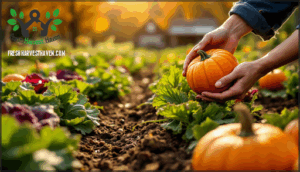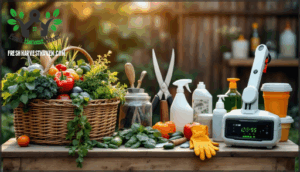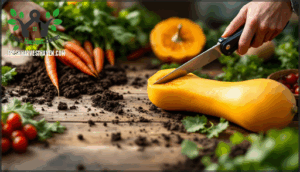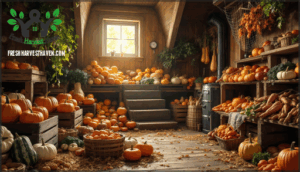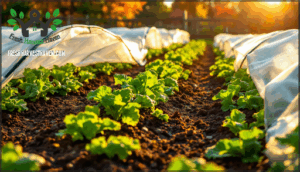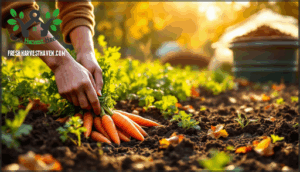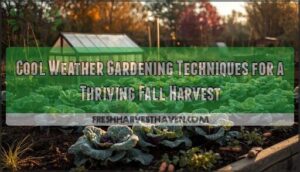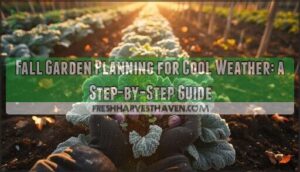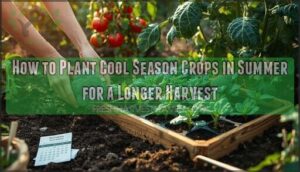This site is supported by our readers. We may earn a commission, at no cost to you, if you purchase through links.
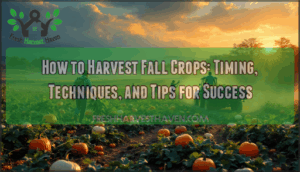
Fall seasonal crop harvesting isn’t just about picking what’s ripe—it’s about timing, intuition, and the right touch. Understanding what makes autumn’s harvest unique can turn your hard work into a winter’s worth of bounty, packed with nutrients and flavor that only peak-season produce delivers.
Table Of Contents
Key Takeaways
- Timing, intuition, and careful handling are central to a successful fall harvest, helping you capture crops at their peak for the best flavor and nutrition.
- Regional climate patterns and unpredictable weather—like early frosts or rain—directly impact when and how you need to harvest your autumn crops.
- Using the right tools and matching your harvest method to each specific crop preserves quality and extends storage life.
- Techniques like succession planting, soil care, and smart pest management boost yields and keep your land productive through the fall and future seasons.
Key Fall Crops Ready for Harvest
Every fall, the fields and gardens start filling up with crops ready to go. You’ll see a wide variety of fruits and vegetables reaching their prime as the air cools down.
Let’s look at which key crops you can expect to harvest this season.
Popular Autumn Fruits and Vegetables
When autumn rolls in, you’ll notice local markets brimming with crisp apples, hearty pumpkins, and all sorts of colorful vegetables that mark the harvest season in full swing. Here are five fall crops that shine this time of year:
- Apple varieties
- Pumpkins for carving and baking
- Root vegetables like carrots and beets
- Leafy greens
- Fall abundance of pears and squash
Regional Crop Harvest Patterns
You’ll find the rhythm of harvest season looks different across the map. In the Midwest, harvesting ripe crops like corn and soybeans peaks as local labor availability shifts. Southern growers may speed things up to beat a shifting climate impact, while out West, late rains and high-tech harvest technology play a big part in how fall crops and regional produce come in.
To plan accordingly, farmers often consult real-time foliage maps to anticipate weather changes.
Nutritional Value of Fall Produce
As fall crops ripen, you’re pulling in some of the year’s most nutritious ingredients. Think about apples packed with fiber benefits and antioxidants, or kale with sky-high vitamin K. Still, keep an eye on vitamin decline—fresh-picked produce loses nutrients quickly.
Each bite of seasonal produce offers diverse mineral profiles and macronutrient content, strengthening your plate all season. Eating produce when it’s in peak season makes certain you get the most nutrients.
Timing Your Fall Harvest for Success
Getting your fall harvest right comes down to timing. There are a few key things to watch for as your crops reach maturity.
Here’s what to pay attention to next.
Understanding Crop Maturity Indicators
Ever wonder how you can tell when a pumpkin is ready to pick or if apples are at their sweetest? Visual indicators—like deep color or firm skin—are key for finding peak ripeness.
Try maturity testing for other crops, too. Each crop variety has its harvest windows, and gathering ripe crops at the right growth cycle keeps post-harvest changes to a minimum.
Effects of Temperature and Weather
When temperature variations swing too high or low, your fall harvest can take a real hit. You might see dramatic effects like:
- Heat stress shrinking maize and soybean yields.
- Frost damage cutting short ripening times.
- Heavy rainfall impact making fields too muddy.
- Shifting season length—thanks to climate change—throwing off your careful timing and pushing you to rethink frost protection.
Scheduling Harvest by Crop Type
When your fields start showing signs that different crops are ready, it’s time to match your harvest schedule to each plant’s own pace. Crop maturity timing varies—think pumpkins versus leafy greens—so watch regional harvest variations and weather impact analysis closely.
Staggered planting benefits you by spreading the harvest season, helping improve your harvest window and use the best harvest methods for each ripe crop.
Step-by-Step Fall Crop Harvesting Techniques
When it’s time to bring in your autumn harvest, a little know-how makes the job easier. The steps you follow can affect both quality and how long your crops last.
Here’s what you’ll want to keep in mind as you get started.
Proper Tools and Equipment
The right tools in your hands can make harvesting feel less like a chore and more like gathering treasure from your own backyard. Precision tools like sharp pruners, sturdy harvest baskets, and lightweight harvesting machinery help you collect ripe crops efficiently.
The right tools turn fall harvesting from hard labor into the satisfaction of gathering treasure from your own backyard
Pair these with cleaning supplies, safety equipment, and proper storage solutions so your harvest produce stays fresh and your experience safe.
Harvesting Methods for Different Crops
Not all veggies and fruits are picked the same way—so how do you know whether to twist, tug, or snip when harvest time rolls around? Manual vs. mechanical harvesting plays a role, but it’s crop-specific techniques that matter.
Lift root veggies gently, snip leafy greens, and cut thick stems. Reduce crop damage and improve efficient harvesting by matching your method to each fall crop.
Post-Harvest Handling and Storage
Ever wonder what really happens after you’ve gathered those baskets of homegrown produce—before they hit your kitchen table? Once you finish harvesting mature crops, your next steps matter.
Dial in storage temperature and humidity control for each type, watch ethylene management so foods don’t spoil early, and focus on pest prevention.
Smart seasonal maintenance directly aids shelf life—and better food production from every fall harvest.
Extending The Fall Harvest Season
As the weather cools down, you still have a few tricks to keep your garden going. Extending the harvest isn’t out of reach if you know what to try.
Here are some practical ways to stretch your fall bounty a little longer.
Succession Planting Strategies
Imagine picking fresh greens from your garden long after summer says goodbye—all thanks to smart succession planting. By staggering your planting windows, you keep beds active with fall crops instead of letting them sit empty.
Good soil preparation, smart crop rotation, and careful variety selection all play a part in extending the fall harvest and guaranteeing a steady supply for your table.
Using Row Covers and Frost Protection
Just when cooler weather starts to creep in, row covers and a little frost protection can help you stretch the harvest even further. Lightweight fabric acts like a blanket, offering crop insulation for everything from lettuces to frost-tolerant greens.
These materials provide weather resistance, keeping your fall harvest going when others pack it in. It’s simple season extension that pays off.
Container Gardening for Fall Crops
With container gardening, you can chase the sun or tuck fall planters close to a warm wall when frosts threaten. Use rich container soil, pick crops that love the cool weather, and water consistently.
It’s a smart move—not just for space optimization, but for enjoying fresh harvests and seasonal blooms right up to the first hard freeze.
Maximizing Yield and Sustainability in Fall
If you want your fall harvest to work harder for you, a few changes can make a big difference. Paying close attention to your soil, pests, and cover crop choices helps you get more from each season.
Here are some smart ways to boost your yields and keep your land healthy.
Soil Health and Nutrient Management
When you want your fall crops to truly thrive, it all starts with paying attention to what’s happening beneath your feet. Good soil health comes from regular soil testing, smart fertilizer application, and adding organic matter like compost topdressing. Keep nutrient cycling strong by always thinking about:
- Soil preparation before planting
- Smart crop rotation
- Consistent nutrient management
Integrated Pest Management Practices
You’ve built up soil health—now guard your fall harvest with Integrated Pest Management Practices. Start by scouting for trouble; crop monitoring and good IPM planning save time, money, and healthy produce. Mix sustainable practices: use biological agents for aphids, add mulching for weed control, and avoid blanket sprays.
Here’s a glance at fall pest management strategies:
| Pest Control Methods | Crop Monitoring | Biological Agents |
|---|---|---|
| Hand-picking | Weekly scouting | Ladybugs for aphids |
| Organic controls | Pest thresholds | Nematodes for grubs |
| Chemical-Free options | Data-driven timing | BT for caterpillars |
Incorporating Cover Crops for Future Seasons
Think of cover crops as your soil’s recharge station, setting the stage for stronger, healthier growing seasons ahead. Here’s why they matter for fall harvest:
- Boost soil health—store nutrients and add organic matter.
- Prevent erosion with quick, dense groundcover.
- Break pest and disease cycles for smart crop rotation strategies.
- Support organic farming methods and sustainable agriculture practices.
Frequently Asked Questions (FAQs)
How does the fall harvest impact local economies?
Picture main streets lined with farmers markets overflowing with seasonal produce. The fall harvest sparks local economies, boosting farm revenue, creating local jobs, fueling economic growth, and inspiring harvest festivals that foster lasting community development in agriculture.
What are best practices for safe field labor during harvest?
Farm Safety begins with proper Worker Training and strict adherence to Labor Laws. Routine Equipment Maintenance, practicing Harvest Ergonomics, and clear safety protocols help reduce injury risks, keeping your team productive throughout the harvest season in modern agriculture.
How do farmers market and sell fall crops efficiently?
Like weaving a patchwork quilt, farmers blend Crop Pricing Strategies with Digital Farm Platforms, leverage Farm Marketing Tools, ride Seasonal Sales Trends, and tap Wholesale Market Options to move fall crops quickly, ensuring fresh seasonal produce reaches anxious markets.
What challenges exist in transporting autumn produce to markets?
Moving autumn produce like locally grown fruits involves high logistics costs, limited cold storage, unpredictable freight management, and tight supply chain timing.
These hurdles can affect market access and delivery of fresh fall harvest and seasonal ingredients to buyers.
How do weather patterns affect pest populations in autumn?
Much like threads weaving a tapestry, shifting weather and temperature drive pest migration in autumn ecology. Climate change alters seasonal pests’ conduct, making weather forecasting essential for gardeners aiming to predict and manage sudden pest surges.
Conclusion
Think of fall seasonal crop harvesting as a careful lantern walk through a quiet orchard at dusk. Each step—choosing the moment, feeling the weight of squash, sensing the weather—shines a light on the land’s hidden reserves.
The patience you show now stores sunlight for colder months, turning the work of your hands into nourishment and strength.
Harvesting isn’t just an end; it’s an invitation to savor what you’ve helped create and a promise of more abundance ahead.
- https://blog.machinefinder.com/16114/a-visual-look-at-typical-united-states-corn-harvest-dates
- https://www.wylr.net/2024/10/25/autumns-abundanceautumn-months-critical-to-crop-production-across-the-u-s/
- https://www.nass.usda.gov/Publications/Todays_Reports/reports/vegean25.pdf
- https://www.usda.gov/farming-and-ranching/plants-and-crops/crop-production
- https://business.edf.org/insights/what-drives-financial-success-in-cover-cropping-new-insights-from-a-three-year-analysis-of-farm-financial-data/

